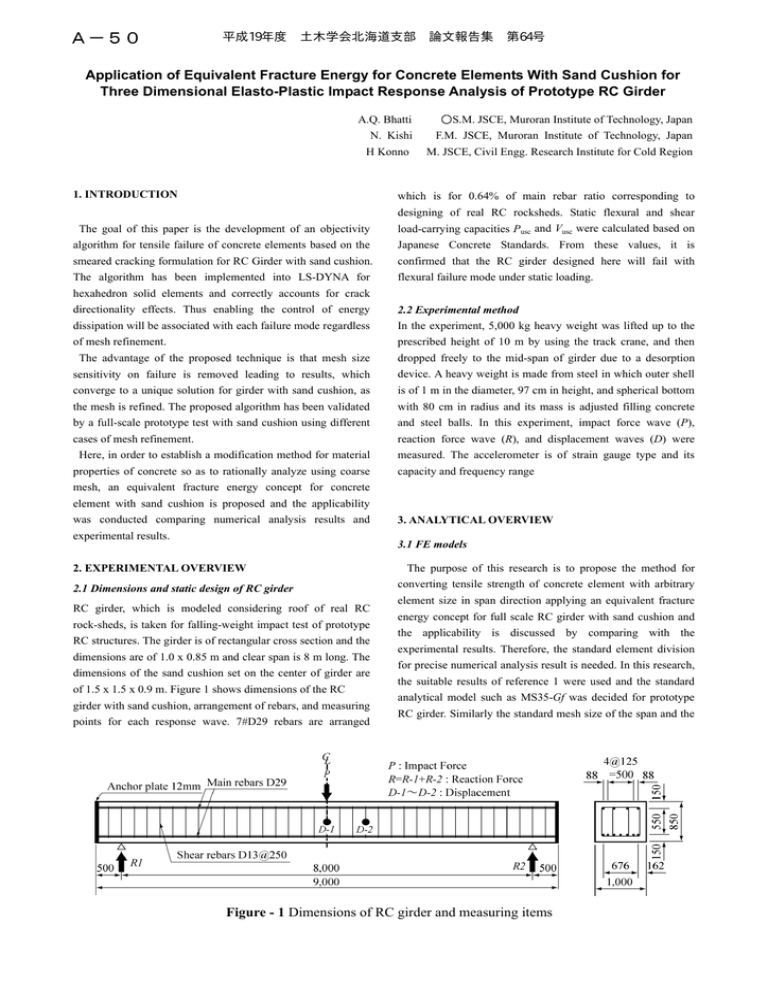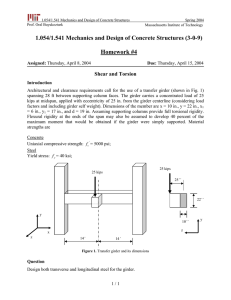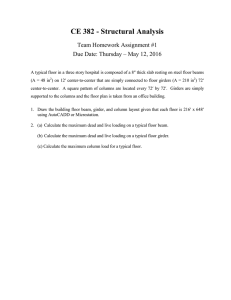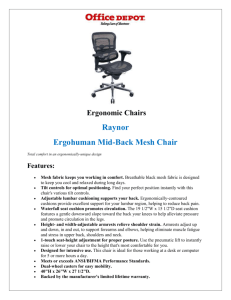Application of Equivalent Fracture Energy for Concrete Elements With Sand... Three Dimensional Elasto-Plastic Impact Response Analysis of Prototype
advertisement

A-50 平成19年度 土木学会北海道支部 論文報告集 第64号 Application of Equivalent Fracture Energy for Concrete Elements With Sand Cushion for Three Dimensional Elasto-Plastic Impact Response Analysis of Prototype RC Girder A.Q. Bhatti 〇S.M. JSCE, Muroran Institute of Technology, Japan N. Kishi F.M. JSCE, Muroran Institute of Technology, Japan H Konno M. JSCE, Civil Engg. Research Institute for Cold Region 1. INTRODUCTION which is for 0.64% of main rebar ratio corresponding to designing of real RC rocksheds. Static flexural and shear The goal of this paper is the development of an objectivity load-carrying capacities Pusc and Vusc were calculated based on algorithm for tensile failure of concrete elements based on the Japanese Concrete Standards. From these values, it is smeared cracking formulation for RC Girder with sand cushion. confirmed that the RC girder designed here will fail with The algorithm has been implemented into LS-DYNA for flexural failure mode under static loading. hexahedron solid elements and correctly accounts for crack directionality effects. Thus enabling the control of energy dissipation will be associated with each failure mode regardless 2.2 Experimental method In the experiment, 5,000 kg heavy weight was lifted up to the of mesh refinement. prescribed height of 10 m by using the track crane, and then The advantage of the proposed technique is that mesh size dropped freely to the mid-span of girder due to a desorption sensitivity on failure is removed leading to results, which device. A heavy weight is made from steel in which outer shell converge to a unique solution for girder with sand cushion, as is of 1 m in the diameter, 97 cm in height, and spherical bottom the mesh is refined. The proposed algorithm has been validated with 80 cm in radius and its mass is adjusted filling concrete by a full-scale prototype test with sand cushion using different and steel balls. In this experiment, impact force wave (P), cases of mesh refinement. reaction force wave (R), and displacement waves (D) were Here, in order to establish a modification method for material properties of concrete so as to rationally analyze using coarse measured. The accelerometer is of strain gauge type and its capacity and frequency range mesh, an equivalent fracture energy concept for concrete element with sand cushion is proposed and the applicability was conducted comparing numerical analysis results and experimental results. 3. ANALYTICAL OVERVIEW 3.1 FE models 2. EXPERIMENTAL OVERVIEW 2.1 Dimensions and static design of RC girder RC girder, which is modeled considering roof of real RC rock-sheds, is taken for falling-weight impact test of prototype RC structures. The girder is of rectangular cross section and the dimensions are of 1.0 x 0.85 m and clear span is 8 m long. The dimensions of the sand cushion set on the center of girder are of 1.5 x 1.5 x 0.9 m. Figure 1 shows dimensions of the RC girder with sand cushion, arrangement of rebars, and measuring points for each response wave. 7#D29 rebars are arranged The purpose of this research is to propose the method for converting tensile strength of concrete element with arbitrary element size in span direction applying an equivalent fracture energy concept for full scale RC girder with sand cushion and the applicability is discussed by comparing with the experimental results. Therefore, the standard element division for precise numerical analysis result is needed. In this research, the suitable results of reference 1 were used and the standard analytical model such as MS35-Gf was decided for prototype RC girder. Similarly the standard mesh size of the span and the Figure - 1 Dimensions of RC girder and measuring items 平成19年度 土木学会北海道支部 論文報告集 第64号 Table - 1. Static design parameters of RC girder Shear rebar ratio Static shear depth ratio Static shear capacity Static bending capacity Shear-bending capacity ratio a/d Vusc (kN) Pusc (kN) ρt α 0.0064 5.71 1794.0 619.8 2.894 Table - 2 Material properties of concrete and reinforcement Density Yielding strength Elastic coefficient Poisson Ratio 3 f’c(MPa) ρ (ton/m ) E(GPa) ν Type Concrete Rebar D13 Rebar D29 2.343 7.85 7.85 25.4 0.177 206 0.3 31.2 390 400 cross section width and height of the RC girder were set as 35 heavy weight elements and between adjoining concrete and mm, 41 mm and 31 mm, respectively based on the previous supporting gigue elements, contact surface elements for those 2) results were defined, in which contact force can be estimated by On the other hand, four cases were considered by assuming 1, applying penalty methods for those elements but friction 3, 5, and 7 division whose element sizes are 250 mm, 83 mm, between two contact elements were neglected. Impact velocity 50 mm, and 35 mm, respectively and those cases are named as was applied to all nodal points of the weight. MS250-Gf, MS83-Gf, MS50-Gf and MS35-Gf respectively. For all cases, each mesh size along the girder near supporting area of 500 mm wide was set to be 35 mm long because of precisely analyzing an interaction between supporting gigues and girders1). The mesh size distribution of each analytical case is shown in Fig. 2. One quarter of RC girder with sand cushion was three-dimensionally modeled for numerical analysis with respect to the two symmetrical axis. Figure 2 shows a mesh geometry of the girder, which is finally used for numerical analysis with optimum design accuracy investigated here. Geometrical configurations of the heavy weight and supporting gigue were also precisely modeled corresponding to the real ones. In this model, axial rebar and stirrup were modeled using beam element having equivalent axial stiffness, cross sectional area and mass with those of real ones. The others were modeled using eight-node and/or six-node solid elements. Total number of nodal points and elements for one-fourth model for MS35-Gf are shown in Fig. 3 are 49,547 and 42,487, respectively. Number of integration points for solid and beam elements are one and four, respectively. In order to take into account of contact interface between concrete, sand and head of 3.2 Modeling of materials The stress and strain relations of concrete, rebar and sand are shown in Fig. 4. The outline of the material physical properties model such as concretes, rebar are shown in Table 2. For the compression region, assuming that concrete is yielded at 1,500 µ strain, perfect elasto-plastic bilinear model was used. For the tension region, tensile strength of concrete is assumed to be one-tenth of compressive strength for the standard case of MS35-Gf but for other cases equivalent fracture energy concept was applied. Fig. 4(c) shows the constitutive model for sand cushion. To rationally analyze in stress behavior of sand cushion when a heavy weight collides, second order parabolic stress-strain relation was applied for sand cushion. Yielding of concrete has been judged based on the Drucker-Prager’s yield criterion. Stress-strain relationship for main rebar and stirrup was defined using a bilinear isotropic hardening model. Plastic hardening coefficient H’ was assumed to be 1% of Young’s modulus Es. Yield of rebar and stirrup was judged Figure - 2 FE mesh size distribution for each analytical case 平成19年度 土木学会北海道支部 論文報告集 第64号 Table - 3. Tensile strength for different analytical cases Element size in span Fictitious tensile strength direction (mm) (MPa) 250 1.18 83 2.04 50 2.64 35 3.12 εto are tensile strength and strain at tensile failure of the standard concrete element. Gf = f t 0ε t 0 V0 2 (1) Ultimate tensile strain εto can be determined as the following equation, f (2) εt0 = t0 Ec Assuming each element size in x, y, and z direction of the standard element as xo, yo, and zo, respectively, the volume of the standard element is as follows: Figure – 3 V0 = x0 y0 z0 FE Numerical analysis model following von Mises yield criterion. Heavy weight, supporting gigues and anchor plates for axial rebars set at the both ends of RC girder were assumed to be elastic body because of no plastic deformation for those being found. 3.3 Equivalent fracture energy concept In this paper, the element was assumed to be failed in the whole area of element because of applying smeared crack model, when negative pressure surcharged to the element reaches a tensile strength. By putting the values of Eq. (2) and Eq. (3), the fracture energy Gf of Eq. (1) can be obtained as, Gf = element size irrespective of magnitude of element size. Based on this equivalent fracture energy concept, each concrete element can retain the equivalent fracture energy due to setting a fictitious tensile strength corresponding to volume of element. In Fig. 5(a), assuming fracture energy of standard concrete element and volume of the element as Gf and Vo, respectively. Gf can be represented as Eq. (1) in which fto and (4) direction of i-element as fti and yi and applying an equivalent fracture energy concept between standard element and i-element, following relationship can be obtained as; ft 20 f ti2 x0 y0 z0 = x0 yi z0 2 Ec 2 Ec of magnitude of element size, the element must be set so as to reaches fracture energy which is the same among all concrete f t 20 x0 y0 z0 2 Ec Here, setting the fictitious tensile strength and element size in y Assuming one flexural crack occurs in a element irrespective be failed at the time when a strain energy stored in the element (3) (5) Fictitious tensile strength of i-element fti can be obtained as follows; fti = f t 0 y0 yi (6) Therefore, taking the fictitious tensile strength fti obtained from Eq. (6) for i-element with yi as the size in y-direction, the crack occurred in the i-element can be rationally estimated similarly to the standard element with fracture energy Gf. The fictitious tensile strength for each element size in y-direction used in this study is listed in Table 3. 4. COMPARISON OF RESUTLS The applicability of the proposed method is examined for the set of each element length for different cases considering Gf in this section and comparing with experimental results. Figure - 4 Stress-strain relation of constitutive model Analytical result concerning all cases with different element 平成19年度 土木学会北海道支部 論文報告集 第64号 Figure - 5 Comparison between experimental and analysis results considering Gf length considering Gf is compared with the experimental results This paper presents a detailed formulation and numerical as shown in Fig. 8. The comparison between results for coarse implementation of an objectivity algorithm for equivalent mesh with considering Gf are shown in Fig.5. fracture energy concept of prototype RC girder with sand The maximum value of impact force wave is smaller than cushion. From this study, it is confirmed that even though the experimental results regardless of the mesh size of the coarse mesh was used for RC girder with sand cushion, similar element length as previously observed. It is understood that the results with those obtained using fine mesh can be assured and response characteristics are similar regardless of the size of the are in good agreement with the experimental ones. The results element length as well as the case of impact force and for the obtained from this study are as follows; reaction force waveform. From Fig. 5(b), it is confirmed that (1) The fictitious tensile strength for coarse mesh has been the reaction force wave at the one supporting point was almost proposed for the prototype RC girder with sand cushion similar to experimental one. It is understood that the amplitude (2) By using the fictitious tensile strength for coarse mesh of D-1/2 as shown in Figs 5(c) and 5(d), the both cycle and the with 250 mm mesh size, similar degree of accuracy can be residual displacement are in the state of a free vibration after obtained by using the fine mesh having mesh size of 35 the maximum displacement regardless of the size of the mm. element length by comparing the experimental results and the (3) However, an incident of the beginning of impact and analytical one. By comparing the experimental results, among maximum amplitude of the impact force time history tend four cases the most underestimating case is MS83-Gf though to be underestimated by comparing with those of the level of the error margin is not large when seeing in detail. experimental results. By converting the tensile strength as the case of MS35-Gf as shown in Table 3, and it can be confirmed to an analytical result of MS250-Gf when the element length is the largest then the analytical accuracy is good enough even if the element division is coarse. Even if the span direction element length is different from a standard element, it means that the mesh size up to seven times the standard element length having the same accuracy as the case to use a standard element by using the fracture energy concept. 5. CONCLUSIONS REFERENCES 1) Kishi, N., Bhatti, A.Q., Okada, S., Konno, H.,: An applicability of impact response analysis method for prototype RC girders under falling-weight impact loading. Journal of Structural Engineering, JSCE, Vol. 52A, pp1261-1272, March, 2006 2) Bhatti, A.Q., Kishi, N., Konno, H. and Okada, S.: Effective finite element mesh size distribution for proposed numerical method of prototype RC girders under falling-weight impact loading, Proceedings of 2nd International Conference on DAPS, Singapore, November 13-15, 2006, pp.261-272





